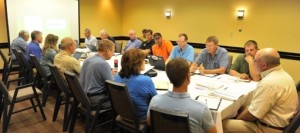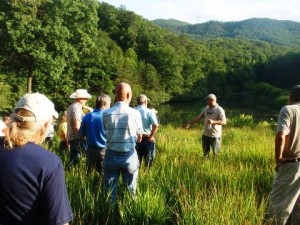 |
Before I bite into the meat of this post, I want say what a privilege it was to serve as chair of the National Bobwhite Technical Committee these last two years. The years were not without substantial challenges, but with such a fine group of steering committee members, NBCI staff, subcommittee chairs and general NBTC members, there was nothing we could not work through. I thank all those who helped me along the way, tolerated my stress, and persevered with me. I look forward to continuing on the steering committee as past-chair through 2016. I also want to thank Todd Bogenschutz, of the Iowa DNR for the great job Todd and his staff and partners did in hosting the 20th annual meeting of the NBTC in Des Moines Iowa last week. Superb job gang!
Now to the title of my post – Volunteer Quail Departments.
It struck me recently that what we are trying to do for quail, that being to develop locally led, community sponsored wildlife conservation, is not unlike the Volunteer Fire Department model. Their model works well and I think it needs to be applied to quail, and perhaps to wildlife conservation in general on private lands. Not every community can afford a full time, professional fire- fighting staff. In fact, most communities can’t. But what they can do is organize volunteer fire departments. These departments rely on government to help them fund equipment, provide training and generally facilitate their efforts, but they are self-driven and rely on local leadership to flourish. They also conduct fund-raisers of their own that contribute significantly to their ability to serve their communities.
I have mentioned in as many places and venues that I can that if you’re sitting around waiting for the government to come rescue quail on your land – you may be waiting a long time. We basically have a “skeleton crew” when it comes to quail recovery. In Virginia there are about seven of us that work most of the time on quail, but none of us work full time on quail. In addition, we have many partners that contribute some of their time to various forms of early-succession wildlife recovery. There are 47,000 farms in Virginia. The math does not add up. At best, we can facilitate, encourage, provide technical expertise and in many cases help secure funding, but the proverbial “quail buck” stops with the landowners. We cannot be everywhere at once and with the huge number of counties each of us covers it is hard to avoid the occasional landowner falling through the cracks. A note on that: if you are a landowner who feels like you may be one of those that have fallen through the cracks, please pick up the phone and let us know – we are human, we make mistakes.
When we started the Quail Management Assistance Program, we envisioned dozens of locally led efforts, spreading “quail quilts” over large areas of Virginia. I still believe that is possible and will ultimately work.
 |
|
One of the most recent and best examples is the “Botetourt County Quail Quilt.” Their effort is an example of a “volunteer quail department” at work. Built around the Longbeards Chapter of the National Wild Turkey Federation, it is a community led effort assisted by private lands wildlife biologist Andy Rosenberger, DGIF District Biologist Dan Lovelace and several other partners.
When he first contacted me, Chairman Ed McCoy was a bit shocked at my candor. When he asked what their chapter could do to help us, my answer was perhaps not what was expected. I told him that what we did NOT need was another chapter of an NGO raising money to hand us a check to go do great things with. Furthermore, we did NOT need a chapter to buy more equipment for our small staff to then have to haul all over the state, taking even more time from their ability to visit new landowners.
I went on to say what we DID need were locally led teams of people willing to work closely with their neighbors and actually help them implement conservation practices (H.I.T. – Habitat Implementation Teams). I told him that we DID need people with equipment in the local area willing to loan it to neighbors, or we DID need a chapter to buy equipment and learn to use it, and then volunteer to help others use it locally.
In addition, we DID need groups of people willing to learn about the habitat requirements of quail and then be willing to fill in the gaps, making landowner site visits when demand was too high for our staff to meet.
Well, their group took the message to heart, having already sponsored a workshop for interested landowners, with another occurring this week. They also plan to have an exhibit at the local county fair. In short, they are taking it upon themselves to grow the effort, and we are supporting them any way we can. This is an excellent example of what we’d call a “volunteer quail department.”
If you are interested in forming one in your area, note that they can be built around a chapter of a non-governmental organization like NWTF, Quail Forever, Quail and Upland Wildlife Federation, The Ruffed Grouse Society or others. By working through an NGO you can get help with fund-raising and promotion. But you do not HAVE to go through an NGO. Your group may choose to develop your own totally local effort. Regardless, I believe this is the way to large scale quail recovery – locally led efforts that focus habitat work, capitalize on government assistance and become force multipliers building a cadre of community volunteers capable of independent operation on behalf of bobwhites.
… a veritable volunteer quail department at the ready to go light quail fires, not put them out.






